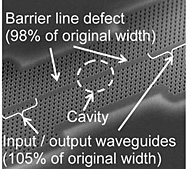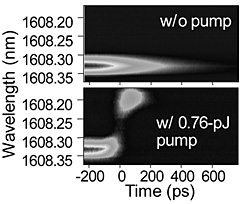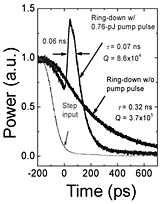Optical Science Laboratory
Photonic crystal (PhC) nanocavities can trap light for longer than a ns
in a volume of less than a µm3 [1]. We propose a new concept for controlling light that involves manipulating
the properties of photons while holding them. This approach has not been
previously considered because of the high speed of light. For example,
we can change the wavelength of light in the same way as the tone of a
vibrating string. The tone of a string can be changed by modulating its
tension even after it has been plucked. When the photon lifetime of a cavity
is sufficiently long we can change the wavelength of the trapped light
by changing the resonance of the cavity [2]. We call this phenomenon adiabatic wavelength shifting. Here we describe an adiabatic wavelength shifting experiment and a demonstration
of a short pulse released from a high-Q cavity by applying this phenomenon [3]. The demonstration of photon release
with arbitrary timing from a high-Q cavity on a chip is the first step toward the development of a true optical memory.
Figure 1 is a scanning electron microscope image of a width-modulated
line defect PhC nanocavity [1, 4]. Because the cut-off wavelength of a
line defect depends on its width, a cavity is created by shifting the air
holes slightly towards the outside of a narrow line defect. Wider line
defects are used as i/o waveguides. The cavity is charged with input laser
light, and then the input is suddenly turned off to record the behavior
of the trapped photons (Fig. 2). We resolved the output wavelengths, and
then recorded their waveforms and confirmed that the output decays exponentially
without any change in its wavelength when no modulation is applied to the
cavity. However, when we apply a pump pulse at a timing of 0 ps from the
top of the slab, a short wavelength component appears, which is due to
adiabatic wavelength shifting. As a result of the carrier-plasma dispersion
effect, both the cavity resonance and the trapped photons shift toward
a shorter wavelength.
When the trapped photons shift towards a shorter wavelength, they become closer to the cut-off wavelength of the narrow line defects. As a result, the confinement barriers become shallower and the light in the cavity can couple more strongly with the i/o waveguides. This enables the immediate extraction of the captured light into the waveguides (Fig. 3). We showed that a pulse with a very small width can be obtained by dynamically changing the coupling strength of the trapped light with the i/o waveguides via adiabatic wavelength shifting.
[1] T. Tanabe et al., Nature Photon. 1 (2007) 49.
[2] M. Notomi et al., Phys. Rev. A 73 (2006) 051803.
[3] T. Tanabe et al., Phys. Rev Lett. 102 (2009) 043907.
[4] E. Kuramochi et al., Appl. Phys. Lett. 93 (2008) 111112.
 |
 |
 |
||||||||
|
|
|